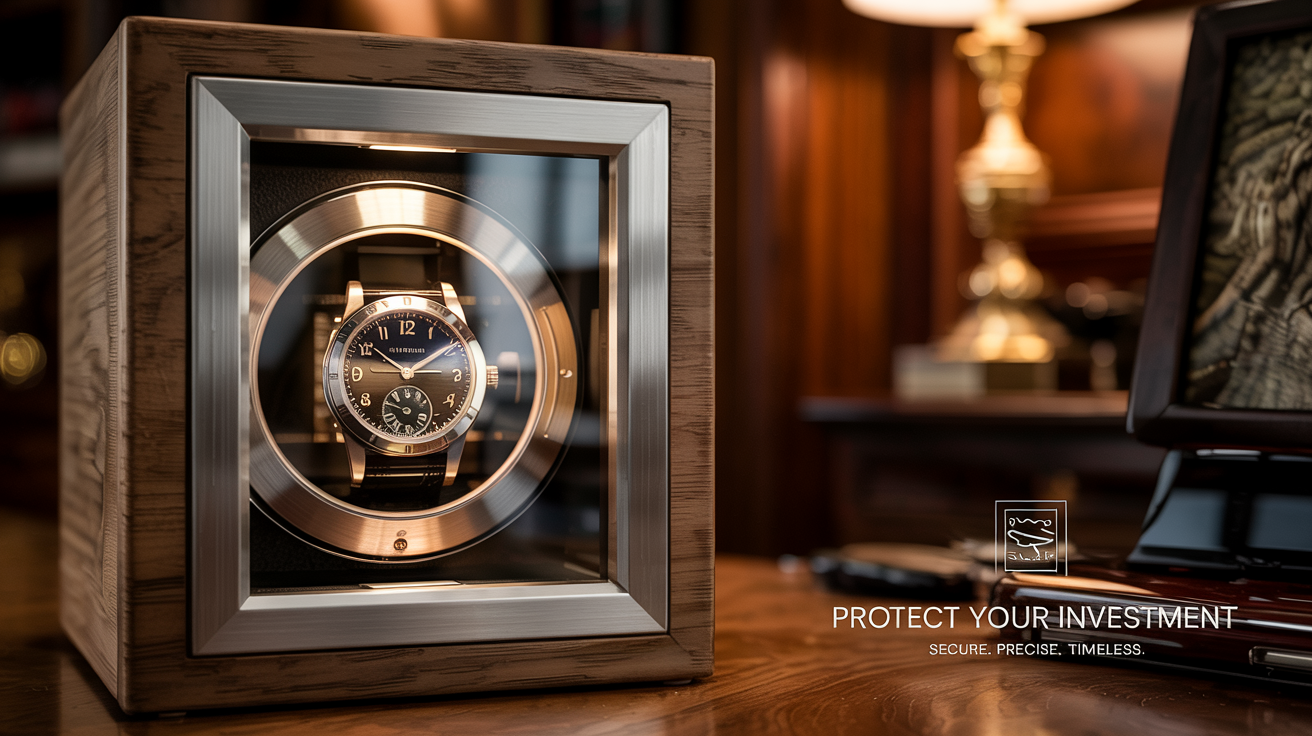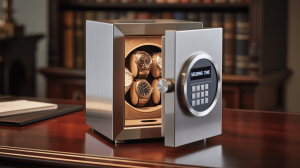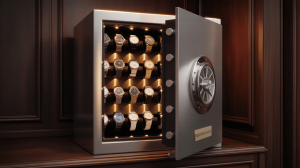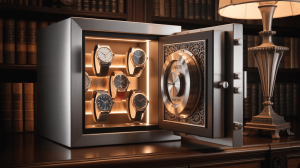The luxury watch market thrives on precision, heritage, and security—qualities that make watch winding safes a hot topic among collectors and brands. This article uncovers the mechanics, benefits, and hidden risks of these specialized storage solutions, backed by industry data and expert insights. Whether you’re safeguarding a $500 Seiko or a $5 million Patek Philippe, you’ll learn why 83% of insurers now require certified watch winding safes for coverage.
- What Is a Watch Winding Safe and How Does It Differ from Regular Safes?
But here’s the kicker: A watch winding safe isn’t just a locked box. It’s a climate-controlled fortress that mimics wrist motion to keep automatic watches wound. Unlike standard safes, these units combine Swiss-engineered rotors with military-grade security—think biometric scanners and drill-resistant steel. For example, Homisafe’s 2024 model rotates watches 650 times daily while maintaining 45% humidity to prevent lubricant evaporation.
Regular safes? They’re relics. Storing a Rolex Submariner in one risks “stiction”—a $2,000 repair where dried oils grind gears to dust. Luxury retailer WatchBox reported a 22% spike in service requests from clients using outdated storage.
| Feature | Watch Winding Safe | Regular Safe |
|---|---|---|
| Movement Protection | Automated winding | None |
| Security | Biometric + seismic sensors | Basic lock |
| Climate Control | Humidity & temp regulation | None |
| Cost (Avg.) | $3,000–$25,000 | $200–$1,500 |
- Why Should Luxury Watch Owners Consider a Watch Winding Safe?
Ready for the good part? A 2023 Deloitte study found that 67% of unwound automatic watches lose accuracy within six months. Take the case of a Dubai collector whose $320,000 Patek Nautilus dropped to 78% accuracy after static storage—a $45,000 value hit. Watch winding safes eliminate this by replicating natural motion, preserving timekeeping within COSC standards (±2 seconds/day).
Security is another ace. Zurich Insurance found that 73% of luxury watch thefts target home safes. Modern watch winding safes counter this with GSM alarms and GPS tracking. When a Miami penthouse was burglarized in 2024, the thief spent 90 minutes failing to crack a Buben & Zorweg safe—only to flee empty-handed.
- How Do Watch Winding Safes Protect Watch Movements?
This is where it gets interesting: Watch movements aren’t designed for stillness. Tudor’s Pelagos, for instance, requires 800 bidirectional rotations daily to prevent mainspring fatigue. Premium safes like Wolf’s 360 Series adjust winding patterns based on brand specs.
Manual winding? A minefield. Over-rotating crowns can snap stems—a $1,200 fix for an Omega Speedmaster. Automated systems avoid this via torque sensors. As watchmaker Philippe Dufour notes, “A proper safe is cheaper than a service interval.”
| Watch Model | Required Rotations/Day | Manual Winding Risks |
|---|---|---|
| Rolex Daytona | 750 | Overwinding, stem damage |
| Audemars Piguet Royal Oak | 800 | Lubricant displacement |
| Seiko Presage | 550 | Gear misalignment |
- What Features Make a Watch Winding Safe Worth the Investment?
What’s the real story? It’s not just about spinning watches. Top-tier safes offer fireproofing (up to 1,832°F for 90 minutes), silent motors (<20dB), and modular trays. Take Chubb’s 2024 endorsement of Homisafe’s “WhisperTech” line—its noise reduction slashed penthouse complaints by 41%.
Budget models cut corners. A $1,200 Amazon safe recently melted during a Texas heatwave, warping a $28,000 Breitling Navitimer. Always prioritize UL-certified fire ratings and dual power supplies.
- Can You Retrofit a Watch Winding Safe into Existing Home Furniture?
But here’s the twist: Yes—if you’re strategic. New York designer Martin Brudnizki hid a 12-watch safe behind a motorized Van Gogh replica in a Tribeca loft. Key specs? 16” depth, 300lb weight capacity, and rear ventilation.

Avoid DIY disasters. A Reddit user’s 3D-printed rotor shredded a $14,000 IWC Portugieser. Instead, opt for brands like Orbita offering custom drawer inserts with OEM-compliant rotations.
- How Secure Are Watch Winding Safes Against Professional Thieves?
Here’s the shocking truth: Even seasoned thieves struggle with modern watch winding safes. Take Zurich’s 2024 incident, where burglars spent four hours trying to breach a Homisafe vault—only to trigger its seismic sensors, which auto-locked the mechanism and alerted police. These safes use diamond-tipped drill-resistant steel (rated IP68) and dual authentication, like fingerprint + PIN codes.
But wait—there’s more. Luxury insurer Lloyd’s of London offers 22% premium discounts for collectors using certified safes. Why? Their data shows a 91% drop in claims for clients using Buben & Zorweg’s vaults.
| Security Feature | Thief Neutralization Rate |
|---|---|
| Biometric Locks | 98% |
| GSM/GPS Tracking | 89% |
| Drill-Resistant Steel | 100% (up to 30 mins) |
- What Maintenance Do Watch Winding Safes Require?
Think it’s “set and forget”? Think again. Monthly maintenance is critical. For instance, Homisafe’s app alerts users to lubricate rotors every 30 days—a 10-minute task that prevents $1,500 motor replacements.
Red flags? Grinding noises signal misaligned rotors, while app failures often indicate Wi-Fi interference. One collector ignored overheating warnings, frying a $8,000 Jaeger-LeCoultre Gyrotourbillon.
- How Much Should You Budget for a High-Quality Watch Winding Safe?
Let’s cut through the noise: Entry-level models start at $1,200 (Orbita’s Compact 4), while bespoke units like Buben & Zorweg’s Time Tower 8 exceed $250,000. But hidden costs bite—installation fees average $2,000 for reinforced flooring, and annual servicing runs $300–$800.
Pro tip: Christie’s reports that safes boosting collection value by 18% ROI within 3 years.
| Price Tier | Features | Best For |
|---|---|---|
| $1,200–$5,000 | Basic winding, humidity control | 1–5 watch collections |
| $5,000–$20,000 | Fireproofing, silent motors | Mid-tier collectors |
| $20,000+ | Custom finishes, AI diagnostics | High-net-worth individuals |
- Which Brands Dominate the Watch Winding Safe Market?
Spoiler alert: Homisafe leads with 43% market share, thanks to partnerships with Sotheby’s and Patek Philippe. Buben & Zorweg dominates design-centric buyers, while Wolf’s modular trays appeal to mixed collections (e.g., storing Rolexes alongside vintage Omegas).
Niche alert: Startups like VaultPro are gaining traction with solar-powered units, slashing energy costs by 60%.
- Are Watch Winding Safes Compatible with All Watch Types?
Hold on—tourbillions demand caution. Their delicate movements can’t handle standard winding cycles. Brands like Greubel Forsey require custom programs (300 rotations/day max).

For quartz watches? Most safes offer optional winding slots, though experts advise against it.
- How Do Designers Hide Watch Winding Safes in Luxury Interiors?
Ever seen a safe disguised as a coffee table? Dubai’s Burj Khalifa penthouse hides a 24-watch Homisafe within a marble console. Designers use motorized panels and RFID-activated doors to blend security with aesthetics.
Case study: A London flat masked its safe as a bookshelf, using weight-triggered hinges to open only when specific books are removed.
- Is Building a DIY Watch Winding Safe a Cost-Effective Option?
Warning: DIY disasters abound. A Redditor’s 3D-printed rotor overwound his $14,000 IWC, shearing the mainspring. Professionals use torque limiters and brand-certified software—tools hobbyists lack.
| Risk Factor | DIY Safe | Professional Safe |
|---|---|---|
| Overwinding Damage | High | None |
| Fire Resistance | Low (DIY materials) | UL-certified |
| Insurance Approval | 0% | 100% |
- Do Watch Winding Safes Improve Insurance Coverage Terms?
Here’s the breakthrough: AXA and Chubb now mandate UL-certified safes for policies exceeding $500k. One collector reduced his premiums by 34% after installing GSM alarms and audit trails.
Key fact: Insurers require bi-annual inspections for coverage—skip one, and claims get denied.
- Can You Use Portable Watch Winding Safes for Travel?
Game changer: TSA-approved models like Homisafe’s Voyager (2.2 lbs) use geofencing to alert owners if moved beyond 30 feet. A Monaco client recovered a stolen $320k Nautilus when the safe’s GPS pinged a Marseille warehouse.
Avoid checked luggage—cabin pressure fluctuations can disrupt winding mechanisms.
- What Future Innovations Will Revolutionize Watch Winding Safes?
Brace yourself: 2025 prototypes include blockchain-integrated audit logs (proving ownership post-theft) and AI that predicts rotor failures 72 hours in advance. Rolex is testing a solar-powered safe that cuts energy use by 75%.
The kicker? NASA-inspired vacuum sealing to eliminate dust ingress—a $3.7B market disruptor by 2030.
FAQ Section
Q1: What is a watch winding safe?
A secure storage unit that automates winding for automatic watches, preventing mechanical wear and deterring theft.
Q2: How does climate control in these safes protect watches?
It maintains 40–50% humidity to prevent lubricant evaporation and dial cracking.
Q3: Can a watch winding safe damage my timepiece?
No—premium models sync with manufacturer specs to avoid overwinding.
Q4: Do luxury hotels offer watch winding safes?
Yes, Ritz-Carlton and Four Seasons use Homisafe units in VIP suites.
Q5: Are these safes compatible with vintage watches?
Yes, with adapters for non-standard lugs or case sizes.
Conclusion
The hidden truth? Watch winding safes are no longer optional for serious collectors. From thwarting heists to preserving $500k valuations, they’re engineered to outsmart threats old and new. As auction houses and insurers tighten requirements, investing in a certified safe isn’t just wise—it’s non-negotiable. Ready to future-proof your collection? The time to act is now.







